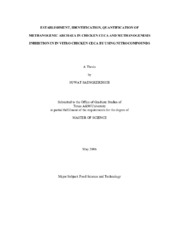| dc.description.abstract | In the first phase of this study, the diversity of methanogenic bacteria in avian ceca was found to be minimal. Based on 16S rDNA clone libraries, a common phylotype, designated CH101, ranged between 92.86 to 100 % of the total clones whereas less than 1% of the other phylotypes were found. On the basis of the sequence identity, all of the sequences, except sequence CH1270, are related from 98.97 to 99.45% to 16S rDNA Methanobrevibacter woesei GS. Sequence CH1270 is 97.62% homologous to the sequence identified to uncultured archaeon clone ConP1-11F. Clearly, the predominant methanogen found to reside in the chicken ceca was M. woesei. By using a MPN enumeration method, methanogen counts were found to be in the range of 6.38 to 8.23 log10 organisms per gram wet weight. The 16S rDNA copy number per gram wet weight in the samples was between log10 5.50 and 7.19. The second phase of the study was conducted to observe the effects of selected nitrocompounds and two different feedstuffs on in vitro methane production in chicken cecal contents and rumen fluid. Initially, one of the three nitrocompounds was added to incubations containing cecal contents from laying hens supplemented with either alfalfa or layer feed. Both feed materials influenced volatile fatty acids (VFA) production and also fostered methane production in the incubations although methane was lower (P < 0.05) in incubations with added nitrocompound, particularly nitroethane. Secondly, nitroethane was examined in incubations of bovine or ovine rumen fluid or cecal contents containing either alfalfa or layer feed. Unlike cecal contents, layer feed significantly (P < 0.05) supported in vitro methane production in incubations of both rumen fluids. The results show that nitroethane impedes methane production, especially in incubations of chicken cecal contents. The final phase of this study was carried out to determine the methanogenic establishment in the chicken ceca by the cultural method with the quantitative PCR. The results suggested that methanogens colonized in chicken ceca at a few days after birth. Litter and house flies could be potential sources for methanogenic colonization in broiler chicks. | en |


